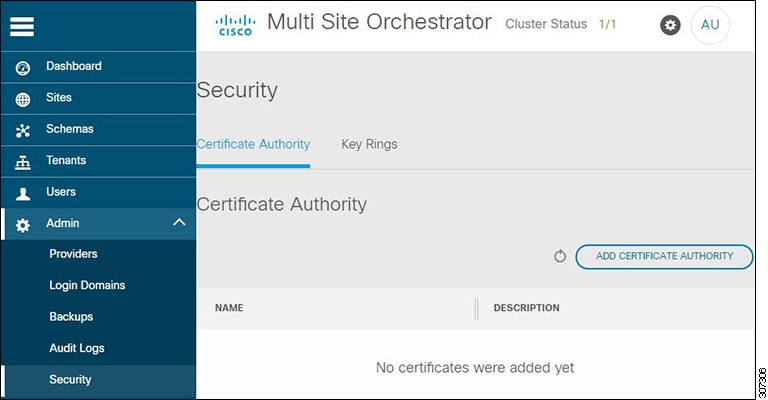Overview of the Cisco ACI Multi-Site Orchestrator GUI
The Cisco ACI Multi-Site (Multi-Site) Orchestrator GUI is a browser-based graphical interface for configuring and monitoring your Cisco ACI, APIC, and Cloud APIC deployments.
The GUI is arranged according to function. For example, the Dashboard page contains an overview of your fabrics and their health, the Sites page provides information on each site and allows you to add sites, the Schemas page allows you to create and configure schemas, and so on.
The functionality of each Multi-Site Orchestrator GUI page is described in the following sections:
The top of each page shows the controller status indicating how many controllers are operational, the Get Started menu icon, the Settings icon, and the User icon.
The Get Started menu provides easy access to a number of common tasks you may want to perform, such as adding sites or schemas, configuring policies, or performing administrative tasks.
The Settings icon allows you to access overview information about your Multi-Site Orchestrator, such as the currently running version, what's new in the current release, system logs, and Swagger API documentation.
-
Clicking the What's New in This Release link displays a short summary of the new features in your release, as well as links to the rest of the Multi-Site documentation.
-
Clicking the System Logs link allows you to configure and download system event logs, which is described in more detail in the Administrative Operations chapter in this guide.
-
Clicking the View Swagger Docs link gives you access to the set of Swagger API object and method references. Using the Swagger API is described in more detail in the Cisco ACI Multi-Site REST API Configuration Guide.
The User icon allows you to view information about the currently logged in user, such as password updates, preferences, bookmarks. It also allows you to log out of the Orchestrator GUI.
-
The Reset Password link allows you to update the currently logged in user's password
-
The Preferences link allows you to change a few GUI options.
-
The Bookmarks link opens the list of all the bookmarked schemas you save while using the Orchestrator. You can bookmark a schema by clicking the bookmark icon in the top right corner of the screen while viewing or editing the schema.
When working with fabric objects, a Display Name field is used throughout the Orchestrator's GUI whenever the objects are shown. You can specify a display name when creating the objects, however due to object naming requirements on the Cisco APIC, any invalid characters are removed and the resulting Internal Name is used when pushing the objects to sites. The Internal Name that will be used when creating the tenant is typically displayed below the Display Name textbox.











 Feedback
Feedback